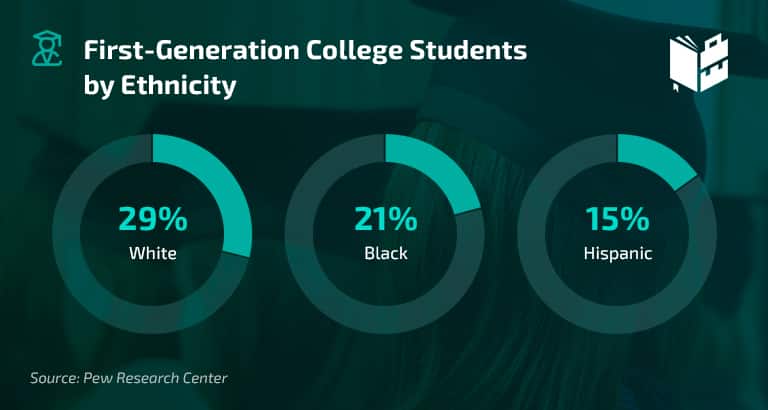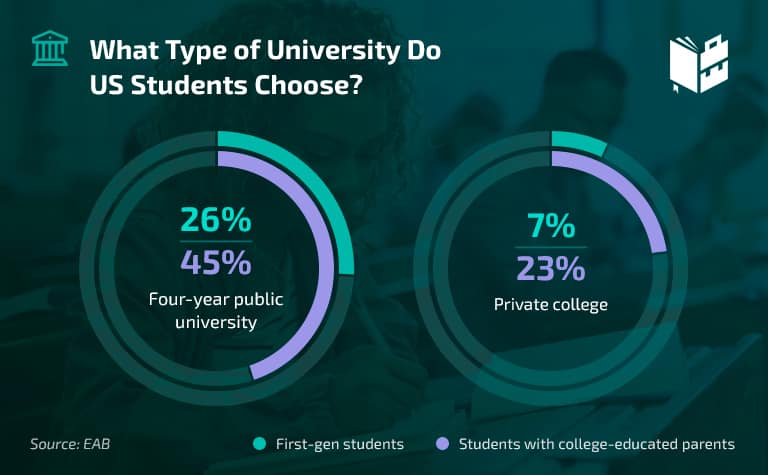The first generation college student statistics you’ll find below point out a complex issue. Namely, a significant part of the student population will start college this year at a severe disadvantage — their parents didn’t go to college.
The parents’ lack of higher education can cause many problems. First, they won’t be able to share valuable college advice with their children. Also, the parents who have a high school degree or less are more likely to struggle with finances.
Read on to find out what challenges first generation college students face and how they cope with them.
Key Statistics on First Generation College Students (Editor’s Choice)
- First generation students comprise a third of all college students.
- 20% of Harvard University freshmen are first generation college students.
- The median household income of a first generation college graduate is $99,600.
- 21% of Black first generation college students graduate.
- 91% of first generation students are sure attending college was the right call.
- 28% of colleges hold data on first generation students.
- 17% of first generation students attend a nonprofit private college.
- 21% of Gen Z students are first generation college attendees.
Recent First Generation College Student Facts
1. 26% of first generation college students have a bachelor’s degree.
(Pew Research Center)
Based on extensive research, college students whose parents didn’t attend college are less likely to earn a degree. Moreover, students with at least one college-educated parent have better chances of getting one. Around 70% of adults aged 22–59 with at least one parent holding a bachelor’s degree or higher have earned a bachelor’s degree.
2. The median household income for a first generation college graduate is $99,600.
(Pew Research Center)
Stats on first generation college students suggest that financial outcomes for adults with a bachelor’s degree depend on their parents’ level of education. In comparison, the median household income in second generation college graduates’ households is $135,800.
3. 20% of Harvard University freshmen are first generation college students in the 2021–22 school year.
(The Harvard Crimson)
Harvard has fewer first gen students among freshmen than last year (22.8%). Moreover, Hispanic students make up 47% of the total number of survey respondents. In addition, African-American students are second with 24.7%, and Asians are third with 15.4%. On the other hand, only 12% of White first gen college students enrolled at Harvard this year.
4. Demographics of first generation college students show that 21% of Black first generation college students graduate.
(Pew Research Center)
Black students whose parents don’t have a degree are less likely to finish college. The same goes for other demographic groups. It’s 29% for White and 15% for Hispanic first generation college students.

5. 90.7% of first generation Harvard freshmen receive financial aid from the university.
(The Harvard Crimson)
The university’s latest survey tells us that most first gen college students have low family incomes. Furthermore, the statistics on first generation college students say 8.2% of the respondents’ families make $125,000 per year. On the other hand, around 70.6% report an annual family income lower than $80,000. Consequently, these college students rely on financial aid, such as scholarships.
6. 15% of students at Brown University are first generation college students.
(Brown University, Statista)
Brown University has witnessed a slight increase in first generation college students. Just three years before, only 11% of them attended its program.
7. 21% of Gen Z students are first generation college attendees.
(Statista)
The survey conducted on 14,000 respondents reveals the percentage of first generation college students born after 1997. More than a fifth of them say they are the first ones in their family to attend college.
8. First generation students comprise a third of all college students.
(NASPA)
First generation college students lag behind their peers in many aspects. For example, only 27% of them graduate within four years, while approximately 44% graduate within six.
Statistics About First Generation College Students — What Applicants Need to Know
9. $1.5 million worth of scholarships goes to first generation college students at Temple University.
(Temple University)
Pennsylvania is another state trying to get more first generation students into its universities. For example, Temple University offers generous scholarships to these students to help them reduce student debt. Students will receive between $500 and $5,000 per year, depending on their individual financial needs.
10. 28% of colleges hold data on first generation students.
(EAB)
Less than a third of all colleges store this kind of data. Moreover, first generation college students’ statistics reveal that not all higher education institutions define the term first generation. In fact, 73% of those institutions find it necessary to acknowledge this student population.
11. The number of students who classify as first gen ranges from 22% to 77%, depending on the definition.
(EAB)
The University of Georgia’s latest survey includes 7,300 students. According to the results, some students are often confused about their first gen status. As a result, many of them miss the chance to take advantage of helpful resources.
12. The first generation college student dropout rate is four times higher than that of the students with at least one parent with a degree.
(Very Well Family)
Low educational attainment is associated with low income. Therefore, first generation college students often drop out because of their parents’ inability to pay for college. Moreover, first gen students often don’t know how to prepare for college because of their parents’ lack of college experience.
Surprising First Generation College Student Statistics
13. About 90% of low-income first generation college students don’t graduate within six years.
(EAB)
Studies show these students often have to work more than 20 hours per week to pay for their education. Managing higher education bureaucracy and practicing good study skills at the very beginning are also some of the problems. These factors keep students from graduating on time.
Read more: Homeschooling Statistics You Shouldn’t Ignore
14. 61% of first gen college students have a professor as their mentor.
(EAB)
First generation students’ statistics indicate that 64% of first generation graduates have a professional mentor who helps them achieve their desired goals. The study gathered data from around 5,107 people. It also shows minority students are least likely to identify a professor as their mentor than the rest of the respondents (47%).
15. Half of the UC Irvine graduates are first generation students.
(Los Angeles Times, UCI)
Not everything is bleak for first gen college students, though. Some states, such as California, are heavily investing in their education. For example, most recent first generation student statistics show that 4,305 out of 8,616 bachelor’s degrees awarded at UC Irvine went to students whose parents weren’t college-educated.
Additionally, 45% of applications for the UC Irvine in 2022 came from first generation college students residing in California.
16. 91% of first generation students are sure attending college was the right call.
(Inside Higher Ed, Civitas Learning)
On the other hand, only 84% of non-first-generation students think that. Moreover, facts about the US college dropout rate tell us that 20% of students who quit college have finished 75% of their degree requirements.
17. First generation college student statistics estimate that Eastern Kentucky University’s GURU program answers 2,000 first generation students’ questions per day.
(EAB)
Many higher education institutions pay special attention to first gen students, and EKU is one of them. This university hired and trained 35 of its students to help their struggling peers with any potential issues — both personal and academic ones.
18. 17% of first generation students go to a nonprofit private college.
(Pew Research Center)
About 29% of prospective students whose parents have a higher-ed degree go to nonprofit private colleges. However, a relatively small percentage of first generation college students in the US choose private education. On the other hand, about 70% of first generation students attend a public university.

Conclusion
Being the first in the family to attend college is an empowering tool for some students. However, for others, it’s a considerable disadvantage because of their low socioeconomic status. Moreover, college student statistics show that worrying about finances during a challenging college program proves to be too much for some.
Luckily, many individuals and institutions are committed to alleviating this burden. Hopefully, future generations won’t find being first gen college students any more difficult than those whose parents have higher education.